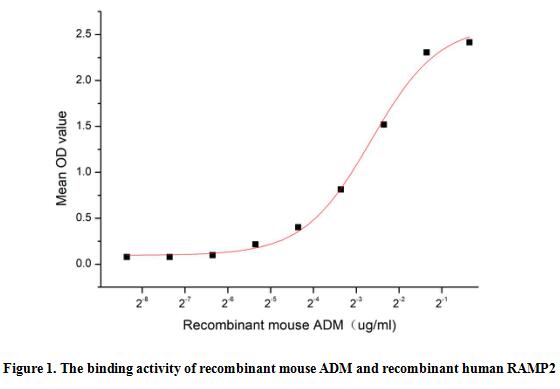Active Adrenomedullin (ADM)
AM; PAMP; Proadrenomedullin N-20 terminal peptide; ProAM N-terminal 20 peptide
- Product No.APA220Mu01
- Organism SpeciesMus musculus (Mouse) Same name, Different species.
- Buffer FormulationPBS, pH7.4, containing 0.01% SKL, 5% Trehalose.
- TraitsFreeze-dried powder
- Purity> 90%
- Isoelectric Point10.1
- ApplicationsCell culture; Activity Assays.
- Download Instruction Manual
- UOM 10µg50µg 200µg 1mg 5mg
-
FOB
US$
For more details, please contact local distributors!US$
For more details, please contact local distributors! US$
For more details, please contact local distributors! US$
For more details, please contact local distributors! US$
For more details, please contact local distributors!
ACTIVITY TEST of the Active Adrenomedullin (ADM)

Adrenomedullin (ADM) is a peptide hormone first discovered in 1993 in pheochromocytoma. Although AM is highly expressed in the adrenal glands, heart, lungs, and kidneys, vascular endothelium and smooth muscle are thought to be the main source of plasma AM. It is a 52 aa peptide with several functions, including vasodilation, regulation of hormone secretion, promotion of angiogenesis, and antimicrobial activity. The antimicrobial activity is antibacterial, as the peptide has been shown to kill E. coli and S. aureus at low concentration. Receptor activity-modifying protein 2 can transports the calcitonin gene-related peptide type 1 receptor (CALCRL) to the plasma membrane. Acts as a receptor for adrenomedullin (AM) together with CALCRL. Thus a functional binding ELISA assay was conducted to detect the interaction of recombinant mouse ADM and recombinant human RAMP2. Briefly, ADM was diluted serially in PBS with 0.01% BSA (pH 7.4). Duplicate samples of 100 μl were then transferred to RAMP2-coated microtiter wells and incubated for 1h at 37℃. Wells were washed with PBST and incubated for 1h with anti-ADM pAb, then aspirated and washed 3 times. After incubation with HRP labelled secondary antibody for 1h at 37℃, wells were aspirated and washed 5 times. With the addition of substrate solution, wells were incubated 15-25 minutes at 37℃. Finally, add 50 µL stop solution to the wells and read at 450/630nm immediately. The binding activity of recombinant mouse ADM and recombinant human RAMP2 was shown in Figure 1, the EC50 for this effect is 0.16 ug/mL.
USAGE of the Active Adrenomedullin (ADM)
Reconstitute in 10mM PBS (pH7.4) to a concentration of 0.1-1.0 mg/mL. Do not vortex.
STORAGE of the Active Adrenomedullin (ADM)
Avoid repeated freeze/thaw cycles. Store at 2-8°C for one month. Aliquot and store at -80°C for 12 months.
STABILITY of the Active Adrenomedullin (ADM)
The thermal stability is described by the loss rate. The loss rate was determined by accelerated thermal degradation test, that is, incubate the protein at 37°C for 48h, and no obvious degradation and precipitation were observed. The loss rate is less than 5% within the expiration date under appropriate storage condition.
INCREMENT SERVICES
BCA Protein Quantification Kit
Molecular Mass Marker for Protein
Monoclonal Antibody Customized Service
Polyclonal Antibody Customized Service
Protein Activity Test Experiment Service
Electrophoretic Mobility Shift Assay (EMSA) Experiment Service
Buffer
Lentivirus Packaging Experiment Service
Adenovirus Packaging Experiment Service
Real Time PCR Experimental Service
Spike RBD Protein (S-RBD)
Protein G
Protein A
Related products
| Catalog No. | Organism species: Mus musculus (Mouse) | Applications (RESEARCH USE ONLY!) |
| APA220Mu01 | Active Adrenomedullin (ADM) | Cell culture; Activity Assays. |
| RPA220Mu02 | Recombinant Adrenomedullin (ADM) | Positive Control; Immunogen; SDS-PAGE; WB. |
| RPA220Mu01 | Recombinant Adrenomedullin (ADM) | Positive Control; Immunogen; SDS-PAGE; WB. |
| PAA220Mu02 | Polyclonal Antibody to Adrenomedullin (ADM) | WB; IHC; ICC; IP. |
| PAA220Mu01 | Polyclonal Antibody to Adrenomedullin (ADM) | WB; IHC; ICC; IP. |
| CEA220Mu | ELISA Kit for Adrenomedullin (ADM) | Enzyme-linked immunosorbent assay for Antigen Detection. |
| LMA220Mu | Multiplex Assay Kit for Adrenomedullin (ADM) ,etc. by FLIA (Flow Luminescence Immunoassay) | FLIA Kit for Antigen Detection. |

